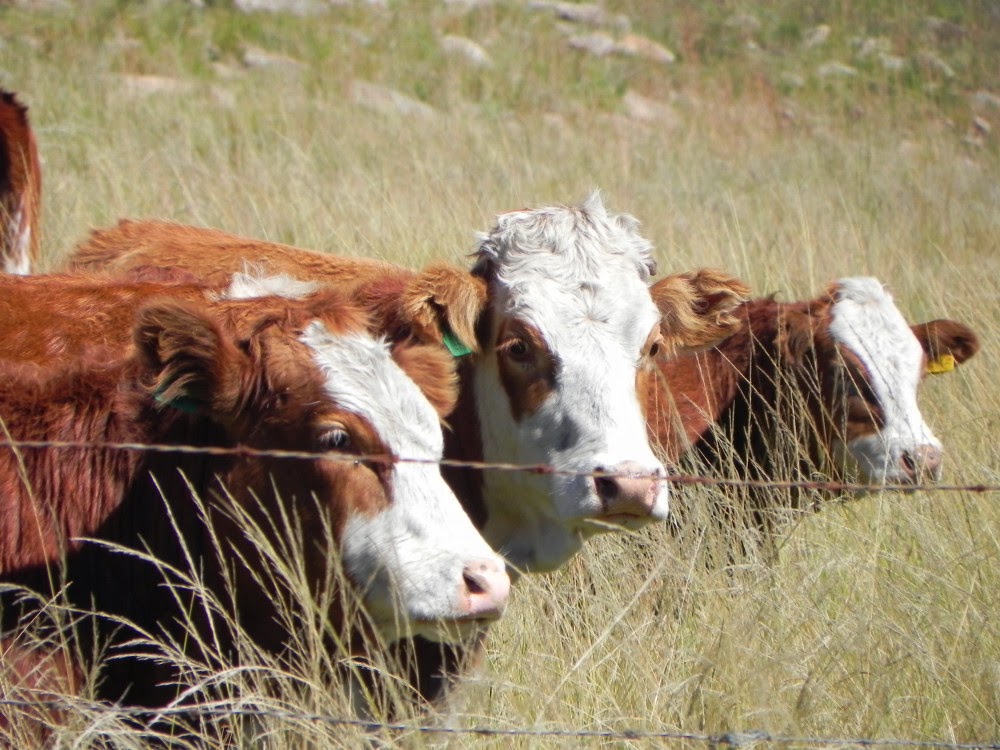This morning I visited our other farm
called Duncraggen. It is a very different farm to Rookwood consisting mainly of
valleys covered with grasslands. The Waqu River originates on this property and
the three streams join on the property and flow into lower Duncraggen as one.
Although Duncraggen does not have the kloofs and kranzes that Rookwood has, it
still is a magnificent farm.
 |
| One of the many views of Duncraggen |
 |
| The 'blue' mountains beyond. |
The highest peak (1 562m above sea level) on Duncraggen is called Vaalkop – believe me it is ‘vaal’ (ashen), yet it gives one the most magnificent 360-degree panoramic view encompassing the Hogsback, Elandsberg, Tafelberg, Mary and Martha, Hangklip and even the Drakensberg on a clear day!
What I enjoy about Duncraggen are the wonderful grassland flowers and plants one discovers while walking in the veldt. Possibly the first different plant I discovered was that of the White Inkflower,(Harveya speciosa) which is actually a parasite and grows on the roots of the grass. They are easy to see as their brilliant white can be seen from far off. However, should the flower be touched it ‘bruises’ into a black colour. Traditionally the roots were pounded with water and the liquid used to clean and drain nasal passages.
 |
| Inkflower |

Another very interesting plant found here is that of the Brachystelma cathcartense, which is quite easily overlooked, but can only be found in this area. Brachystelma plants are perennial with usually annual stems and fleshy roots, clustered or in a disc-like stem tuber. Tubers of many of the species are eaten by animals and people. The Brachystelma cathcartense flowers in mid-summer.
 |
| Oxbane lily |
 |
| Sore eye lily |
Being grassland there are also a number of
bulbous type plants including the two Amaryllis lilies, the Oxbane (Boophone disticha) and the Sore eye lily
(ammocharis corancica), the latter
not as abundant.
 |
| Gladious mortonius |
Recently the Gladious mortonius (no common name)
can be seen flowering all over the farm. It is a gorgeous gladiolus with large
flowers that face slightly downwards.
 |
| Kniphofia found on the hillside |
Another very pretty flower is that of the
Kniphofia species. Two different ones occur on the farm – the ones that are
seen in the river flower normally towards the end of summer. The other
species is found up against the hills. I have yet to positively identify them.
 |
| Kniphofia found in the rivers |
This morning while photographing a butterfly
near the kraals, I came across this very interesting puffball mushroom. The fungi can be identified as a Mosaic puffball (Calvatia utriformis) and it is the first one I have ever seen.It is
a rather large mushroom, and may reach dimensions of up to 25 cm broad by 20 cm
tall. I love the Afrikaans name – Netvormstuifbal!
 |
| Mosaic puffball |
Autumn is the time of the year for
butterflies and I managed to photograph this Yellow Pansy (Junonia hierta cebrene) feeding off the Yellow
Startwort (Senecio bupleuroides). The
veldt has many butterflies some small and some bigger. They certainly are not
easy to photograph as they are not still for too long.
 |
| Yellow Pansy butterfly |
Last August Duncraggen was completely burnt out
from a veldt fire. Fanned by the typical August winds we experience, the whole
farm was burnt out within an hour.
Fortunately we had not stock losses due to
the heroic deeds of our neighbour Lyndon Snelling and both his and our staff. This
fire went on to burn out an area of over 7 000hectares in total.
 |
| Jackie running through the Rooigras at Duncraggen before the fire |
The stark devastation of what was once an area covered
with lots of Rooigras (Themeda tiandra) to a burnt lunar landscape cannot be forgotten.
We were forced to ‘trek’ our cattle back to
Rookwood as there was no grazing left.
 |
| The slow recovery of the burnt veldt |
This took its toll on the cattle as for the following three months, grazing became limited on Rookwood as the spring rains had not come.Duncraggen likewise battled to recover from this fire.
 |
| Aloe pratensis |
 |
| Fire lily flowering |
I found the cycads (Encephalartos friederici) most amazing and looking at the
photographs from immediately after the fire to 3 months later, one can only be
amazed at their resilience. No wonder they are considered to be the most
primitive living seed bearing plants in the world.
 |
| The cycads a day after the fire |
 |
| The cycads 8 weeks after the fire |
 |
| The cycads finally showing 'life' again. |
When the rains did arrive in November, the veldt
started waking up with various plants flowering.
 |
| Aster bakeranus |
 |
| Golden sedge |
 |
| One of the small Mesembryanthemum species found in the grass |
Being able to take my mom up to Duncraggen in early December and to let her sit amongst these flowers was wonderful. Flowers have always been part of her life.
I so often wonder why we do not plant more indigenous plants.
Duncraggen is also home to a lot of
different birds as well as little reptiles of different types that I will share
in another blog.
The cattle are looking good and the veldt recovering well. I realize that like Rookwood, Duncraggen has still many secrets to share with me.
 |
| Young heifers at Duncraggen |







Your photos are beautiful Kate!
ReplyDelete